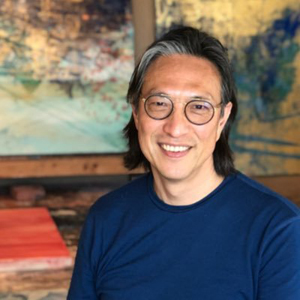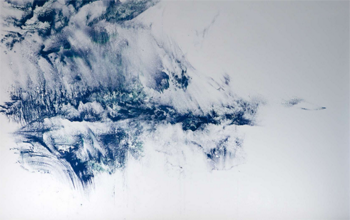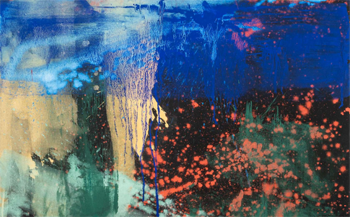From https://makotofujimura.com/about
Makoto Fujimura (b. 1960, Boston) is a leading contemporary artist whose process driven, refractive “slow art” has been described by David Brooks of the New York Times as “a small rebellion against the quickening of time.” Robert Kushner, in the mid 90’s, has written on Fujimura’s art in Art in America this way: “The idea of forging a new kind of art, about hope, healing, redemption, refuge, while maintaining visual sophistication and intellectual integrity is a growing movement, one which finds Makoto Fujimura’s work at the vanguard.”
Fujimura’s art has been featured widely in galleries and museums around the world, and is collected by notable collections, including The Museum of Contemporary Art in Tokyo, The Huntington Library, as well as Tikotin Museum in Israel. His art is represented by Artrue International in Asia, and has been exhibited at various venues, including Dillon Gallery and Waterfall Mansion in New York, Sato Museum in Tokyo, The Tokyo National University of Fine Arts Museum, Bentley Gallery in Arizona, Gallery Exit and Oxford House at Taikoo Place in Hong Kong, Vienna’s Belvedere Museum, and Shusaku Endo Museum in Nagasaki. He is one of the first artists to paint live on stage at New York City’s legendary Carnegie Hall as part of an ongoing collaboration with composer and percussionist Susie Ibarra.
Fujimura's newest book is Art and Faith: A Theology of Making (Yale, 2021).
The following interview comes from the online website "The High Calling" by Becky Garrison, see here: https://www.theologyofwork.org/the-high-calling/blog/called-creativity-art-and-work-interview-makoto-fujimura-part-1
In Refractions: A Journey of Faith, Art, and Culture, artist Makoto Fujimura pens a series of essays exploring life, art, and faith. Makoto spoke with us recently in a two part interview about what it means to be an artist and how we can all be creative in our daily work.
 |
|
Makoto Fujimura. Image from https://twitter.com/iamfujimura/photo
|
How do you see your work as your calling?
I knew that my work as an artist was my calling before I was a Christian. You can't really commoditize art. The pure artists feel called to do what they do despite enormous difficulties such as not being able to market their works or having an audience necessarily at that moment. This made more sense after I became a Christian, and I knew who called me and to what purpose. One of the things that I discuss in the book is how the process of creativity and the journey of faith overlap. In fact, I was part of a study group called the Faith and Work Group at Yale that examined: “Why is it that Sunday faith is not translated into Monday through Saturday?”
What did you learn from that study group?
I wrote an essay in the book titled “Optimum Foraging Theory: Can You Have Your Birds and Eat Them Too?” It was based on the experience of our group touring the Tyson Factory and thinking through what it means to have a calling of some kind but also have a market reality.
As a Christian, how do you deal with the commercialized aspect of the art world?
Recently, I have been writing in Refractions and on my blogs about the necessity for the market system in the art world to change into more of a hybrid system. Instead of being based purely on the celebrity-driven, ego-infested market system, it would really take into account one's creativity and the biblical paradigm of Shalom prosperity. That's different from just having market prosperity. God plans for us to be thriving in our creativity. Therefore, there has to be an over-arching system that accounts for that. While there are a few pockets of Shalom prosperity, currently, there is no system like that in place. The church should be one of the first places where that could be possible.
What do you think keeps the church from not being one of those places?
I think it's bought into the commoditized system. It's driven by market desires and consumer mentality. We have big churches, which is not bad in itself, but with mall-like structures and 20th century evangelism, the church kind of turned itself into salesmanship of the gospel—where it can be bought or sold. And the person receiving the gospel is either buying it or not buying it. That's a problem in many ways, as we can imagine.
The ineffectiveness of our not being able to create that hybrid system leads to the gospel being boiled down to some level of commodity. As a church, we need to really reconsider this system by recreating our system and calling for systemic change.
How do you glorify God in your daily work?
I glorify God by fulfilling my calling and being faithful in small things. But it's also about being willing to stand for my faith in certain ways. I do that by being authentic and integrating my faith journey with my art. I work with whoever I work with—whether it be a gallery or the whole system that is driven by a celebrity market system with ideologies that are somewhat opposed to biblical values—but I love the art world instead of disengaging from it.
 |
|
Walking on Water by Makoto Fujimura. From https://makotofujimura.com/art
|
How do you achieve that balance?
Jeremiah 29 calls us to pray for the prosperity of the city in which God has called us into exile. We are in exile. That's just the reality. But that doesn't mean we can disengage and run away from it. Jeremiah tells us to plant gardens and settle down and get married, which means a long incarnational journey to live and work in the place of exile and to honor God there as Daniel did. We become a better Babylonian than the Babylonians.
What Scripture verses or Bible stories influence your art?
Well, the entire Bible is written by our Creator God for broken creative people of God to create and love. That's how I read the Bible; it's a creative book to be read as our creative journey. So, to me, every single verse in Scripture is filled with creative principles that we can learn from—not for the sake of creativity, but for the sake of sanctification and our journey toward the City of God.
What is the biggest spiritual challenge you face in your work?
I would say it is the market pressure, because I have to survive and feed my family as a full-time artist. So, you toil and labor under the curse. Unfortunately, it's very hard to make what I do sustainable because of market pressure and lack of support from the world and from the church. You have to be entrepreneurial. I'm fortunate that I have that capacity, but a lot of people don't. Oftentimes, that puts them at risk in the world. And yet, God has been kind to me and my family and has sustained us as I fulfill my calling. I consider that a daily miracle.
Speaking of family, how do you juggle your family, your ministry, and your art all at the same time?
I talk about that in the book. It's really an amazing miracle and journey that certainly is a juggling act. I do it because I believe it's important. My journey as an artist and what I create is directly linked to advancement of God's kingdom somehow. If I didn't have a conviction, it would be hard to make it work. But at the same time, there's wisdom there that involves making sure that I have a team around me that protects me from burning out, so my work can be sustainable.
What does your work teach you about your faith in the person of God?
I learn a lot from the process of painting—even the frustration of the business side of things or my own failings in what I desire to accomplish. I hope they are teachable moments for me. Creating art is essentially a discipline in which one learns to deal with these frustrations. They are birth pangs that are constantly there in front of me as I work. And, I struggle through that. It's hard work. But in the end, it is utterly rewarding and reveals very much the process that Paul talks about in Romans 8 where the whole creation is waiting for sons of God to be revealed. This whole birthing process, as it were, is repeated in smaller ways on the surface with my paintings. Even as I write, I experience that. Everyone in a creative field experiences that.
What led you to create the International Arts Movement?
 |
|
Four Holy Gospels by Makoto Fujimura. From https://makotofujimura.com/art
|
I was living in exile and living in the gap and knowing that there's very little support to fulfill my calling as an artist, not in this market system. I was trying to make art sustainable. So, whether you're a Christian or non-Christian, there's some support. That's why International Arts Movement (IAM) is not a Christian ministry, but it is an arts organization—nonprofit arts organization run by Christians. We see art as a primary place to wrestle with deeper issues of art and faith and humanity.
How does IAM influence the New York City art world?
First of all, we're a very small organization. So, we can only be a catalytic organization. We partner with other organizations as well as work with churches and sometimes non-Christian organizations, because we believe that this calling to rehumanize is very much needed from all spheres. I believe creating the “world that ought to be” is a necessary calling for every human being. It's part of my “shalom” calling as well. God has instituted this calling for me, my family, and IAM to work toward peace and prosperity of the city.
We don't create a nice, comfortable place for ourselves. That's because we feel that struggling through the public sphere and all the pluralistic context that we have to deal with is good for us. Thus, we learn to speak in a language that is not tilted and biased and built on fear of what the other side is doing, but we learn to mediate in our culture on what is true and essential about humanity.
How do you facilitate this dialogue with IAM?
We have public dialogs in all sorts of spheres in the arts and business. In the future, we're even going to involve scientists as well, because the issue of rehumanization affects everyone. Here at IAM, we have a vantage point of doing that through the arts. While that's our central point, our conferences, our lectures, and now the Internet are wide open. Anybody can sign up to be a member for free on our site and join in. It's really a wonderful adventure to have a movement to be a resource to people in their creative journeys.
On May 2, 2021 JWJ will post "Part 2" of this interview.
Dan Clendenin: dan@journeywithjesus.net
Image credits: (1) Twitter.com; (2) Makotofujimura.com; and (3) Makotofujimura.com.


